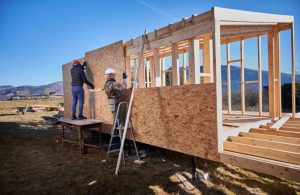A Beginner’s Guide to Prefabricated Extensions

In recent years, prefabricated extensions have become an increasingly popular choice for homeowners looking to expand their homes in a cost-effective and efficient manner.
With a focus on affordability, speed, and minimal disruption, house extensions in South London have surged in popularity.
This blog will guide you through the essentials of prefabricated home extensions in the UK, covering their benefits, materials, types, and why they might be the perfect solution for your home improvement project.
What are prefabricated home extensions?
Prefabricated home extensions are built in sections off-site and then assembled at your home, making them quicker and less disruptive than traditional extensions. They offer a practical way for UK homeowners to add space without the long waiting times of conventional building methods. Prefabricated roof extensions, for example, can greatly expand your living space with minimal disruption.
What are the benefits of prefabricated extensions?
Many homeowners are now looking at prefabricated extensions as a faster and more affordable alternative to traditional building methods. Here are some of the key advantages:
1. Time efficiency: Prefabricated extensions can be completed much faster than traditional extensions. Since much of the work is done off-site, the assembly process on-site is relatively quick, reducing disruption to your daily life.
2. Cost savings: One of the main reasons homeowners opt for prefabricated extensions is the cost. Due to the factory-based construction and efficient assembly, prefabricated extension costs tend to be lower than traditional builds. This makes them an attractive option for those working within a budget.
3. Design flexibility: Although they are prefabricated, these extensions offer a wide range of design options. Whether you want a modern, sleek design or something more traditional, a prefabricated home extension can be designed to suit your needs and style preferences.
What is the best material for prefabricated houses?
There are several materials used in the construction of prefabricated extensions, each offering unique advantages.
1. Timber: Known for its natural aesthetic and excellent insulation properties, timber is a popular choice for those looking for sustainability.
2. Steel: Steel is incredibly durable and strong, making it ideal for larger extensions that require structural integrity.
3. Composite: A combination of different materials, composite offers strength, durability, and a modern appearance.
Each material has its own benefits, but the best material depends on your home’s specific needs, aesthetic preferences, and budget.
How many types of prefabricated extensions are there?
If you’re looking to expand your home, a prefabricated extension can be a fast and cost-effective choice. But how many types of prefabricated extensions are there? Let’s take a look at the main options available:
1. Prefabricated roof extensions: These are ideal for homeowners looking to add additional space without expanding the footprint of their property. Roof extensions can enhance both the functionality and value of your home.
2. Modular extensions: Modular extensions involve pre-made sections that are assembled on-site. This is a flexible option, as sections can be designed to suit various purposes, such as additional living spaces or home offices.
3. Other types: From kitchen extensions to garden rooms, there is a wide range of prefabricated options available to suit different needs.
Choose Doran Bros Construction for house extensions in South London
Prefabricated extensions in the UK offer homeowners an affordable, efficient, and flexible way to expand their living space. From roof extensions to modular designs, there are plenty of options to explore.
If you’re considering a home extension in South London, get in touch with us for expert advice and a high-quality service that will transform your home!

